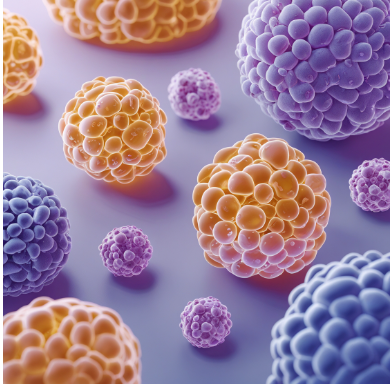Cell culture is a game-changer in scientific research. It’s all about growing cells outside their natural environment. This technique helps scientists study diseases, test new drugs, and even create vaccines. Cell culture is shaping the future of biotechnology, changing how we understand human biology and leading to big medical breakthroughs.
Key Takeaways
| Aspect | Description |
| Definition | Growing cells outside their natural environment in controlled conditions |
| Main Types | Primary cell culture and immortalized cell lines |
| Key Applications | Drug development, cancer research, vaccine production, regenerative medicine |
| Challenges | Contamination, ethical considerations, regulatory compliance |
| Future Trends | 3D cell culture, organoids, AI-assisted research |
What is Cell Culture?
Cell culture is like giving cells a home away from home. Scientists take cells from animals or humans and grow them in special containers. These containers have everything the cells need to live and grow. It’s like a tiny city for cells! The controlled environment mimics the conditions found in living organisms, providing nutrients, growth factors, and optimal temperature and pH levels to support cellular growth and multiplication.
Cell culture has been around for over 100 years. Back in the day, scientists used it to study viruses. Now, it’s used for so much more. There are two main types of cell culture:
- Primary cell culture: These are cells taken directly from living tissue. They’re like fresh ingredients in cooking. Primary cells closely resemble the original tissue but don’t live very long and can be tricky to keep alive.
- Immortalized cell lines: These are cells that have been changed to keep growing forever. They’re like a never-ending supply of ingredients. These cells have been genetically modified or come from tumors, allowing them to divide indefinitely in the lab.
Cell culture helps scientists in many ways. They use it to test new medicines, study cancer, and make vaccines. It’s like having a mini-lab that shows how our bodies work! This technique allows researchers to watch how cells behave, test new ideas, and develop new treatments in a controlled environment, speeding up scientific discoveries.
Key Cell Lines in Research
HeLa Cells: The Pioneers of Cell Culture
HeLa cells are super famous in the science world. They come from a woman named Henrietta Lacks, who had cervical cancer in the 1950s. These cells were the first human cells to grow well in a lab. They’ve helped scientists make big discoveries about cancer and genetics. HeLa cells have helped create the polio vaccine and advance research in cancer, gene mapping, and how radiation affects human cells.
Explore Cytion’s HeLa cell products to kickstart your research.
HEK293 Cells: The Protein-Making Machines
HEK293 cells come from human embryonic kidney cells. They’re great at making proteins that scientists need for their experiments. These cells are like tiny factories that help create new medicines. HEK293 cells are used a lot in biotechnology and drug research because they’re easy to work with and can make human-like proteins.
Check out our HEK293 cell offerings for your protein production needs.
Jurkat Cells: The Immune System Explorers
Jurkat cells help scientists understand how our immune system works. They come from a type of white blood cell called T cells. These cells are super important for studying diseases that affect our immune system, like leukemia. Jurkat cells have helped scientists learn how T cells work and communicate, giving us valuable information about how our immune system functions and what happens when it doesn’t work right.
Discover Cytion’s Jurkat cells line for immunology research.
CHO Cells: The Biopharmaceutical Workhorses
CHO stands for Chinese Hamster Ovary. These cells are really good at making complex proteins that we use as medicines. They’re like the superheroes of the biopharmaceutical world, helping to create treatments for many diseases. CHO cells are the most common cells used to make therapeutic proteins, including antibodies, because they can make proteins that work well in humans and they produce a lot of these proteins.
Explore our CHO cell products for biopharmaceutical production.
Applications of Cell Culture in Modern Science
Cell culture is used in many areas of science:
Drug Development
Testing new medicines safely
Cancer Research
Understanding cancer growth
Vaccine Production
Creating life-saving vaccines
Regenerative Medicine
Growing new tissues and organs
Challenges and Ethical Considerations
Cell culture is amazing, but it’s not always easy. Here are some challenges:
- Contamination: Tiny invaders like bacteria can ruin cell cultures. Scientists have to be super clean to prevent this. Contamination can lead to wrong results, wasted resources, and messed up research. Strict cleaning techniques and regular testing are important to keep cultures pure.
- Ethics: Some cell lines come from people. Scientists have to be careful to respect the rights of the people who donated cells. This includes getting permission, protecting privacy, and making sure everyone can benefit from the research.
- Rules and regulations: There are lots of rules about how to use cell cultures safely and ethically. These rules cover things like safety, genetic changes, and using human and animal cells in research. Following these rules is important for keeping researchers and the public safe, and making sure scientific research is done right.
The Future of Cell-Based Research
Cell culture is changing fast. New technologies are making it easier to grow cells in 3D, which is more like how they grow in our bodies. Scientists are also using artificial intelligence to help understand cell cultures better. These new tools are helping us model complex biological systems more accurately and speed up discoveries.
One exciting area is organoids. These are tiny, simplified versions of organs grown in the lab. They could help us test new medicines and understand diseases better without using animals. Organoids might change how we do personalized medicine, test drugs, and study how organs develop and diseases work.
Conclusion
Cell culture is a powerful tool in biotechnology. It helps scientists make new discoveries and create life-saving treatments. From HeLa cells to CHO cells, each type of cell culture plays a unique role in advancing science. The flexibility and adaptability of cell culture techniques continue to drive innovation across various fields of biomedical research.
As we look to the future, cell culture will continue to be at the forefront of medical breakthroughs. It’s an exciting time for cell-based research, with new technologies opening up possibilities we’ve only dreamed of. The combination of advanced imaging techniques, microfluidics, and high-throughput screening platforms with cell culture is paving the way for more sophisticated and predictive in vitro models.
Ready to start your cell culture journey? Discover high-quality HeLa, HEK293, Jurkat, and CHO cells at Cytion.com today! Our expert team is here to support your research needs and help you push the boundaries of scientific discovery. Whether you’re a seasoned researcher or just starting out, Cytion provides the tools and expertise you need to unlock the full potential of cell-based research in your laboratory.











